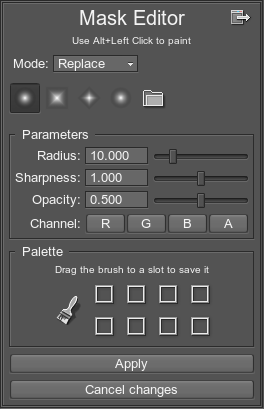Mask Editor
UnigineEditor provides a useful tool for painting image masks directly in the scene - Mask Editor. It allows editing the existing image masks and creating new ones.
See Also
- The chapter on Image Mask for the Grass Field
- The Adding Grass tutorial.
- The chapter on Masking Areas with Objects for Mesh Clutters and World Clutters.
Creating Mask with Mask Editor
To create a new image mask by means of the mask editor:
- Run UnigineEditor.
- Add ObjectGrass, ObjectMeshClutter or WorldClutter to the scene by choosing the required object via the Menu bar (the Create menu item).
- Specify all the required settings for the added object.
- Choose Windows -> Nodes (or press N) to open the Nodes window.
- In the nodes hierarchy list, select an ObjectGrass, ObjectMeshClutter or WorldClutter node and go to the Grass, MeshClutter or Clutter tab correspondingly.
- Here, click
 arranged opposite the
Image mask field.
arranged opposite the
Image mask field.

- Specify the size of the mask in the window that opens.

- In the file dialog window that opens, specify the mask name, choose the folder to save the mask and click Ok. The empty image mask will be created.

- Perform Steps 4-7 described below to paint the mask.
Editing Mask with Mask Editor
To edit an image mask by means of the mask editor:
- Run UnigineEditor.
- Choose Windows -> Nodes (or press N) to open the Nodes window.
- In the nodes hierarchy list, select an ObjectGrass, ObjectMeshClutter or WorldClutter node and go to the Grass, MeshClutter or Clutter tab correspondingly.
- Here, click
 arranged opposite the
Image mask field.
arranged opposite the
Image mask field.
The mask editor will open.
- In the mask editor, specify the required brush settings.
- Choose the channels of the image mask to edit by clicking the corresponding buttons (R, G, B, A).
- Hold Alt + Left Mouse Button to paint the mask in the scene.
Mask Editor Options

| Mode | Available modes:
|
|---|---|
| Brushes | Shape of the brush:
|
| Radius | Size of the brush. |
| Sharpness | Tip of the brush. The lower the value, the sharper and smaller the tip. The higher the value, the flatter and bigger the tip. |
| Opacity | The rate to apply the brush. |
| Channel | Channel of the mask to edit. |
| Palette | The brush palette allows saving all the parameters of the current brush to be used as a preset later. For that, drag the
 icon to the palette. The palette is shared for all image masks. icon to the palette. The palette is shared for all image masks.
|
Last update: 21.12.2017
Помогите сделать статью лучше
Была ли эта статья полезной?
(или выберите слово/фразу и нажмите Ctrl+Enter
 - circular shape
- circular shape
 - square shape
- square shape
 - diamond shape
- diamond shape
 .
.